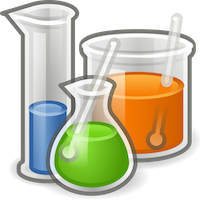Blog: Significant Figures

Sig Fig blog
Page Index
- Must-know Definitions
- Must-watch Videos
- Fundamentals
- Exact Numbers
- Introductory Challenge Questions
- Student Q&A
Must-know Definitions
Chemistry relies heavily on precise data measurememts.
What is a Measurement?
Measurements can be thought of as having two parts: a number, and a unit. For example: 55 mL, where the number 55 specifies the quantity, and the unit mL identifies the item measured.
measurement = number + unit
The precision of the number is specified by the number of significant figures to which it is reported.
Must-watch Videos
Four videos which explain, and provide detailed examples, for the assignment of any situaion you will encounter in an IntroChem or GenChem course.
- ① significant figure core concepts — sig fig basics... introduction to following three videos
- ② Box-and-Dot Method — how to determine the number of sig figs (and sig places) in a given number
- ③ SF for simple math operation — how to determine the number of sig figs in the answer to a mathematical (+ − × ÷ ) operation
- ④ SF for complex math operation — how to determine the number of sig figs in the answer to a complex mathematical operation (one which involves at least one + or − operation, and at least one × or ÷ operation)
Fundamentals
• One-page summary of the box-and-dot method for determining significant figures on only two steps:
CLICK HERE
• Textbook discussion of Sig Figs in Calculations, with print and video examples:
CLICK HERE
Exact Numbers
Exact numbers should be ignored when determining significant figures (SF). This is because exact numbers are infinitely precise, and hence cannot be the least precise number in a calcuation. It is the least precise number — the "weakest link" — which ultimately determines the number of SFs in the result of a calculation.
In general, exact numbers are those which are determined by counting (as opposed to calculated), or those which are defined (e.g., by definition, there are 1000 g in a Kg.)
Which types of numbers are considered “exact?” Below are some general rules. If the number is not included among those listed here, the safest thing is to consider it not exact.
- Conversions between units within the English System are exact. e.g. 12 in = 1 ft or 12 in/1 ft (In this conversion, 12 and 1 are both exact.)
- Conversions between units within the Metric System are exact. e.g. 1 m = 100 cm or 1 m/100 cm (In this conversion, 1 and 100 are both exact.)
- Conversions between English and Metric system are generally NOT exact. Exceptions will be pointed out to you.
• 1 in = 2.54 cm exactly (1 and 2.54 are both exact... an exceptional case)
• 454 g = 1 lb or 454 g/1 lb (454 has 3 sig. fig., but 1 is exact... a typical case) - “Per” means out of exactly one.
• 45 miles per hour means 45 mi was measured in exactly 1 hr, or 45 mi/1 hr. (45 has 2 sig. fig. but 1 is exactly one.) - “Percent” means out of exactly one hundred.
• 25.9% means 25.9 out of exactly 100 or 25.9/100 (25.9 has 3 sig. fig., but 100 is exact.) - Counting numbers are exact. Sometimes it is hard to decide whether a number is a “counting number” or not; but in most cases it is obvious.
• There are 5 students in the room. (5 would be an exact number because you cannot have a fraction of a student in the room. One arrived at the number 5 by counting, not by measuring.)
• subscripts in a formula, and coefficients in a balanced equation, are considered “counting numbers” and are exact - Mathematical constants are exact.
• The symbol π (pi) is exact; however, the number 3.14 has only three significant figures, while 3.1416 has five.
In a mathematical formula, such as V = (4/3)πr3, or P.E. = ½ mv2, the fractions are exact numbers. - The conversions between Celsius, Fahrenheit, and Kelvin temperatures are exact. This means the fractions (5/9 or 9/5) and the number 32 are exact. The number 273.15, in the Celsius to Kelvin temperature conversion, is also exact.
- Speed of light in a vacuum is exact, and is equal to 299,792,458 m/s
Introductory Challenge Questions
So, can you tell at a glance to how may significant figures the following answer is good? (These were recorded from measurements, and hence the numbers are NOT exact):
Question 1: (888 + 999) / 7777 = ?
If not, you still have a ways to go with the sig fig concept.
Several are still asking questions about sig fig calculations (and that's a good thing if you are still not understanding). Here are some additional exam-level questions, answers and tips which seemed to help those who asked. Of course, the detailed videos provided on the Youtube website (IntroChem Exam 1 Playlist) should be your primary source of info on this topic.
Question 2: 123 + 7 = ?
Question 3: 120 + 10 = ?
Let's drill down on each of these questions.
Answer to Challenge Question 1:
- The answer is good to 4 sig fig, not three.
-
The numerator operation is an addition, so you must use the PLACES RULE, not the SIG FIG rule, for the 'top' part.
REMEMBER: count Places when you add/subtract; count Sig Figs when you multiply/divide.
- 888 + 999 = 1887, which is good to the 1's place. Note that 1887 has four sig figs, whereas the two numbers from which is was derived (888 and 999) each have only three sig figs.
-
BUT, to complete the problem I have to first perform the Box-and-Dot on this new number (1887).
Why? Because I am now going to use it as a part of a second mathematical operation — I'm going to divide something into it.
Note that I am not dividing 7777 into 888 (3sf), nor am I dividing it into 999 (3sf); rather, I am dividing it into 1887 (4sf).
I think this is where a lot of you are getting tripped up with co-called complex problems.
Work out the addition/subtraction step completely, before you move on to the multiplication/divisions step. -
My 'new' problem is now: 1887 / 7777 = ?
From this point, it is easy to see the final answer should be reported to 4 sig fig.
- The actual answer is: 0.2426
Answer to Challenge Question 2:
- Adding the numbers 123 + 7, your calculator will give you the digits 1 3 0
-
Each number being added (123 and 7) is good to the 1's place, so the answer must be good to the 1's place.
Because you added, you counted Places, not Sig Figs. -
If you just leave the digits as they are, you have then number "130", which is wrong b/c 130 is only good to the 10's place.
(Do the Box-and-Dot on 130 to prove it to yourself) -
To make the zero digit in the 1's place significant, you must add a decimal (dot) after it.
(Step 2 of the Box-and-Dot Method states, "If you see a dot, then box trailing zeros"
The logical corollary of which is, "You must add a dot if you want trailing zeros to be significant.") -
The correct answer is therefore: 130. (with a decimal after the zero)
REMEMBER: your calculator will always give you the correct DIGITS, but is rarely gives you the correct NUMBER.
I am defining a Number as ① a correct sequence of digits, that are ② reported to the correct number of significant figures.
Your calculator is perfect at ①, but hit-or-miss at ②.
Answer to Challenge Question 3:
- Adding the numbers 120 + 10, your calculator will give you the digits 1 3 0
- Each of the two numbers being added (120 and 10) is only good to the 10's place, so the answer can only be good to the 10's place.
- If you just leave the digits as the calculator provides, you have then number "130" ... which by mere luck, this turns out to be correct!
This is a calculator case of "the blind hog found an acron". The calculator guessed you didn't need a decimal after the zero, and in this case, you didn't!
This turns out to be the essence of the problem. Sometimes the calculator gives you the correct number, and other times it doesn't. So, if you don't understand what you are doing, then you don't know why it's hit-or-miss with your answers, and hence a perpetual state of confusion. It's not hard, you just have to know the few simple rules, and pay attention and apply them to measured numbers.
Student Q&A
Q: CHEM 1305 I01- Question about video 8.05
Professor Stephenson,
I am studying with a classmate and we are watching the videos. We both wondered if in a stoichiometry problem if you always round up or down as you did in the example. The answer the calculator gave was 16.16 however the answer you wrote was 16 g.

